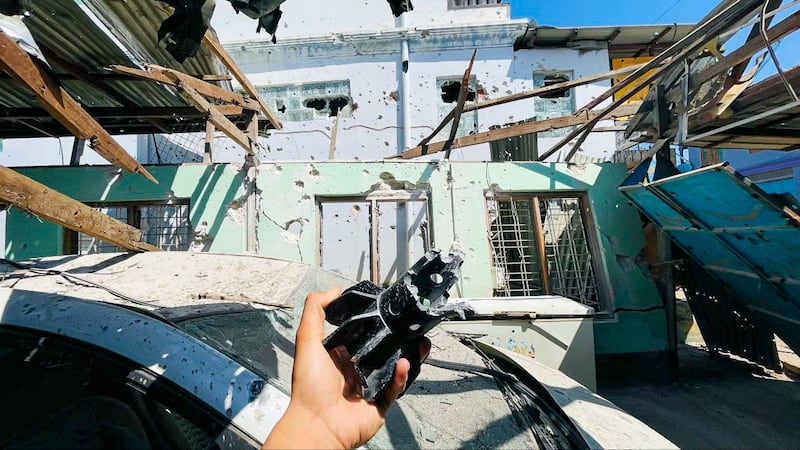[ Read this story in Burmese Opens in new window ]
Myanmar’s junta is conducting regular airstrikes and artillery attacks on towns in northern Shan state that are firmly under rebel control in a resurgence of violence in the area, residents said Thursday.
On Monday, the ethnic Ta’ang National Liberation Army, or TNLA, said that the air force dropped more than 50 bombs on Hsipaw with Y-12 aircraft, and that aerial attacks were being carried out every day on Nawnghkio. Both towns are under TNLA control.
The attacks are the latest spasm of violence in Myanmar’s three-year civil war, in which rebels appear to have the upper hand, prompting the military to lash out at towns under their control.
While armed clashes are taking place in Nawnghkio township’s Tawng Hkam village, the junta has repeatedly targeted the township seat with airstrikes and artillery attacks,
a resident of Nawnghkio who, like others interviewed for this report, spoke on condition of anonymity due to security concerns, told RFA Burmese.
“They are also carrying out airstrikes on places where there is no fighting,” he said. “They have been firing heavy weapons from [the nearby township of] Pyin Oo Lwin for four or five days. Yesterday, their attacks hit houses. No [rebel] forces are stationed there.”

The TNLA captured key junta artillery battalions in Nawnghkio on Aug. 28 and fighting around the township’s remaining military outposts has continued since then.
Another Nawnghkio resident, who also declined to be named, told RFA that the junta is carrying out “continuous airstrikes” in this area.
"Around 2-3 a.m., the junta dropped about five bombs, possibly using Y12 aircraft,” he said, adding that no one was hit in the attacks.
Recent casualties
On Sept. 13 and 14, at least 10 bombs were dropped by aircraft on Nawnghkio town, residents said, while on Sept. 17, junta artillery shells killed three members of the same family – Cho Myint, 40, and two boys aged 3 and 17.
A recent junta airstrike on Hsipwaw town injured a 60-year-old woman and a 14-year-old girl, while also destroying several houses, the TNLA reported on Wednesday.
A resident of Hsipaw told RFA that fighting had intensified in the township beginning last week, and the junta has been carrying out aerial attacks since then.
“TNLA totally controls the town, except for the military’s No. 23 Light Battalion,” he said. “Junta troops are trying to retake this camp. Airstrikes were used in the fighting, hitting residents and killing some people.”
RFA was unable to independently confirm the exact number of casualties.
RELATED STORIES:
[ Myanmar’s old army leader calls on China to help restore stabilityOpens in new window ]
[ China’s frustration with the Myanmar junta’s incompetence mountsOpens in new window ]
[ As Myanmar junta falters, rival ethnic armies jostle in Shan stateOpens in new window ]
Fighting began in Hsipaw in the last week of June, when the second round of a major ethnic offensive known as 1027 Operation began. On Aug. 10, the TNLA took control of all parts of Hsipaw after junta troops withdrew from Hsipaw Bridge and the town center.
Attempts by RFA to contact Khun Thein Maung, the junta’s economic minister and Shan state spokesman, for comment on the use of airstrikes in the area went unanswered Thursday, as did efforts to reach TNLA spokeswoman Lway Yae Oo.
According to the health ministry under Myanmar’s shadow National Unity Government, or NUG, on Sept. 7, the junta carried out 11 airstrikes in Shan, Kayah and Chin states, as well as Sagaing, Magway, Mandalay and Bago regions, killing more than 40 people.
During the second round of Operation 1027, the opposition forces under the NUG seized Mandalay region’s Mogoke, Singu, Thabeik Kyin and Tha Gaung townships, as well as several townships and the towns of Moemeik, Naunghkio, Hsipaw and Lashio in northern Shan state.
End of cooperation with NUG?
Meanwhile, a ethnic army that helped launch Operation 1027 with the TNLA said it will cease fighting and end its cooperation with the NUG militarily or politically.
The rebel Myanmar National Democratic Alliance Army, or MNDAA – which, along with the TNLA and the Arakan Army, or AA, form the ethnic Three Brotherhood Alliance – said in a statement on Wednesday that it will not align with any group that opposes neighboring China and said it will work with Beijing to bring an end to Myanmar’s conflict.
Also known as the Kokang Army, the MNDAA said that despite taking control of much of northern Shan state, including the largest city Lashio, it has no plans to seize the state capital Taunggyi or Myanmar’s second-largest city Mandalay.
However, the group did not go as far as announcing an end to hostilities with the military and said it would defend its territory and pursue autonomy if necessary.
The ethnic army had posted a similar statement to Facebook on Sept. 4, after China warned rebel groups to end fighting with the junta along its southern border, but later took it down.
The NUG has provided no response to the MNDAA statement.
Observers suggested that the MNDAA statement was the result of intense pressure from China, which has shut down key trade routes along the border amid fighting there.
Media outlet Myanmar Now cited political commentator Than Soe Naing as saying that the MNDAA was “simply announcing the direction laid out for them by China.”
The junta has accused Beijing – one of its few remaining international supporters – of backing the TNLA and MNDAA, with junta chief Senior Gen. Min Aung Hlaing saying in early August that the military lost Lashio because of China’s involvement.
Later that month, Min Aung Hlaing met with Chinese Foreign Minister Wang Yi in Naypyidaw, after which the Chinese embassy issued a statement suggesting that external forces were attempting to damage China-Myanmar relations.
Translated by Aung Naing. Edited by Joshua Lipes and Malcolm Foster.
